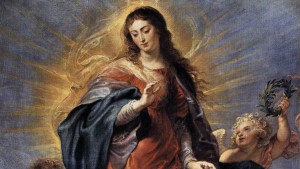In the liturgical calendar of the Roman Rite of the Catholic Church, there exists the Solemnity of the Immaculate Conception of the Virgin Mary on December 8. It is a feast that is often confused with the conception of Jesus Christ, which is celebrated with the Solemnity of the Annunciation on March 25 (nine months before Christmas day). The December 8 feast, though, refers to Mary’s conception in the womb of her mother, Ann.
What does the “Immaculate Conception” mean?
The Catechism of the Catholic Churchlays out a basic definition.
To become the mother of the Savior, Mary “was enriched by God with gifts appropriate to such a role.” The angel Gabriel at the moment of the annunciation salutes her as “full of grace.” In fact, in order for Mary to be able to give the free assent of her faith to the announcement of her vocation, it was necessary that she be wholly borne by God’s grace.
Through the centuries the Church has become ever more aware that Mary, “full of grace” through God, was redeemed from the moment of her conception. That is what the dogma of the Immaculate Conception confesses, as Pope Pius IX proclaimed in 1854:
The most Blessed Virgin Mary was, from the first moment of her conception, by a singular grace and privilege of almighty God and by virtue of the merits of Jesus Christ, Savior of the human race, preserved immune from all stain of original sin.
CCC 490-491
For some, it is a difficult teaching to understand, as it centers on the teaching that God, outside of time, applied the merits of Jesus’ sacrifice on the cross to the Virgin Mary at the moment of her conception.
The Canonry of St. Leopold expounded on this truth, as described in a previous article at Aleteia.
[God] took the grace and salvation which would come from His plan to enter into the world, become a man, suffer, die and rise, and he gave the grace to Mary before He actually did it.
This is not a time-traveling episode in a science fiction series (although maybe we are fascinated with time travel because of the Immaculate Conception!) but rather what the theologians call prevenient grace, the grace that worked before (in time!) its source had appeared!
So, God lifted up Mary with this grace — to be, as it were, as if it had been she, Mary, in the Garden, without the burden of Original Sin. And so, she is the Immaculate Conception – conceived in the womb of her mother without the stain of Original Sin.
It is a great mystery of the Catholic faith, one that may be difficult to comprehend, but fits into the “logic” of salvation history. He sought to prepare a vessel for him to come into the world as Savior and Redeemer, and chose Mary, the daughter of Joachim and Ann, to fulfill his plan. It shows his tenderness to humanity and the great love he poured out upon the Virgin Mary, to grant her such a grace. He wanted the best for his earthly mother!
If you struggle with this teaching, it is appropriate to say the prayer of the father whose son was cured by Jesus Christ, “I believe; help my unbelief!” (Mark 9:24).

Read more:
Why is Mary the Immaculate Conception patroness of the United States?

Read more:
Celebrate the Immaculate Conception with Schubert’s “Ave Maria”

